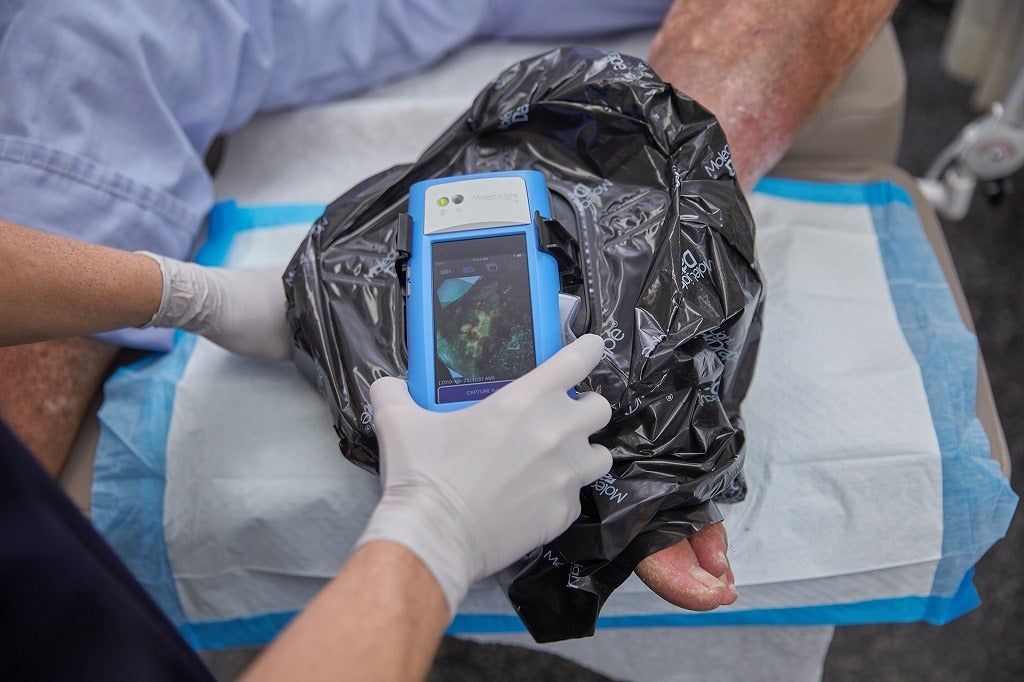A two-year study conducted in the UK recorded a 23% improvement in wound healing after treatment with fluorescence point-of-care imaging

A growing body of evidence supports the use of fluorescence point-of-care imaging for better healing rates (Credit: MolecuLight)
A new study conducted within the UK NHS between 2018 and 2020 suggests the use of fluorescence point-of-care imaging can positively impact wound-healing rates.
In the published results, the use of MolecuLight fluorescence point-of-care imaging increased the number of diabetic foot ulcer wounds healed within 12 weeks by 23%.
Between 2018 and 2019, 101 patients suffering with the ulcers were not treated with the technology, giving the baseline for comparison, and in the following year 128 were.
Nadine Price, study author and podiatrist at the Whipps Cross Hospital where the study was conducted, said: “Diabetic foot ulcers and their bacterial burden produce a significant strain on the NHS and I wanted to understand and quantify the effects of point-of-care fluorescence bacterial imaging on the costs and patient-healing rates since the MolecuLight i:X was implemented at our clinic.
Rather than treating the wound directly, fluorescence point-of-care imaging is a diagnostic tool that allows clinicians to get an accurate picture of bacteria quantity and virulence to tailor treatment plans per individual.
During the period of fluorescence imaging using the MolecuLight i:X the number of wounds seen at the clinic increased by 27%, and annual antimicrobial dressing expenditure decreased by 33% in year two.
Implementation of fluorescence imaging was associated with a 49% decrease in the prescription of antimicrobial dressings and a 33% decrease in antibiotic prescriptions.
“Beyond the significant realised cost savings that the study uncovered, the fluorescence imaging procedure has had a noticeable impact on the quality of wound care provided to patients, without detriment to our clinical workflow,” said Price.
“Having the ability to know at point-of-care whether a wound has significant levels of bacteria that may be indicative of infection enables us to offer the safest care for our patients and provides instant clinical feedback on treatment efficacy.”
Growing evidence to support fluorescence point-of-care imaging in wound healing
The study conducted by Price added to a growing body of evidence to support the use of fluorescence point-of-care imaging in wound healing.
In one large September 2020 study, which included 350 patients, the MolecuLight i:X device detected four times the amount of bacteria as the standard clinical severity score method.
Dr David Armstrong, Professor of Surgery, Director of the Southwestern Academic Limb Salvage Alliance (SALSA) at the Keck School of Medicine of the University of Southern California, as well as the US-appointed delegate to the International Working Group on the Diabetic Foot (IWGDF), believes the device is necessary to improve treatment decisions for wounded patients.
“To improve decision-making and care with DFU patients we must be able to measure what we manage,” he said.
“The MolecuLight i:X is a powerful tool for screening DFUs for infection as well as monitoring new or worsening bacterial burden over time.
Commenting on Price’s study, he said it provides “further data for the improved healing rates, reduced antimicrobial usage and reduced costs that can be achieved in a clinic with routine use of fluorescence imaging to detect wound bacteria.”




